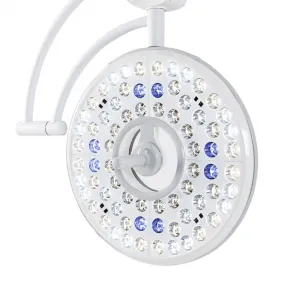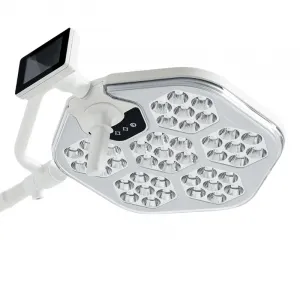Surgical Lights Should Not Be A Distraction
Patient safety is a top concern for all of healthcare, including the OR. Considering that every 7.5 minutes, surgical lights need repositioning during surgery, this can lead to unnecessary distractions during a procedure.
When surgical lights are readjusted 97% of the time, the surgeon must stop their current surgical task to complete the lighting adjustment. Equipment distractions, including light adjustments, are one of the most significant distractions during a surgical procedure.
Brightness is not the only factor that may lead to surgical light adjustments. There are several other factors to look into before purchasing. This article covers the most important factors to consider when making a significant investment in your facility.
More Than Shining Bright
Brightness is something you must consider before purchasing, however, there are several other factors to consider as well.
- Quality of light components and manufacturing
- Lifespan
- Heat emission
- Infection control
- Adjustable settings for brightness and color temperature
A bright surgical light is great, but if you have to replace it after a year, it is not very cost-efficient. Heat emission during surgeries can have negative effects on patients and healthcare workers, especially during extended surgeries. As always, decreasing the risk of infection during surgery is always a top priority.
Surgical Light Brightness
It may not be the only factor to consider, but brightness is an essential factor when choosing the best surgical lights. If a surgical light is too bright, it may cause glares, hindering the surgeon’s vision during a procedure. In contrast, if the light is too dim, they will not see properly to do the procedure. This will lead to even more frequent adjustments.
How do you choose the proper brightness? The brightness, or intensity of light, is measured in units called LUX or Footcandles. Footcandle is the Imperial measurement standard and Lux is the metric standard. For our purpose we will reference in the more common Lux metric standard. The conversion is 1 footcandle equals 10.764 lux.
| Lighting Condition | Typical Illuminance |
|---|---|
| Thresh hold of seeing | 1 lux |
| A candle at 1 foot | 10.764 lux |
| Professional office | 500 lux |
| Examination room (emergency department) | 1000 lux |
| Operating room (general room lighting) | 9300 lux |
| Surgical light / operating room light head | 40 000-160 000 lux |
For surgical lighting Lux is determined by the amount of illuminance measured at 1 meter from the source. Be sure you are comparing apples to apples when buying as some lights may claim higher illuminance but at a shorter measurement distance.
In certain circumstances 40,000 lux is adequate in a surgical setting, however many major surgery and operating room lights can reach the maximum recommendation of 160,000 lux. Be sure your surgical light has a maximum of at least 100,000 lux. This is because it is critical to provide ample light into the actual work field and surgical cavity. In some cases 160,000 lux is too much illumination and can cause eye strain, glare, or a washed out effect, so its important to be able to easily adjust the power to a level that is optimized for changing scenarios.
Other considerations that relate directly to Lux output in terms of providing clear clean light include:
- Shadow delusion and management from light pattern and reflectors
- Color temperature settings (3000K to 6000K)
- CRI ( Color Rendering Index ) and quality of LED configuration: CRI between 95 to 98 is excellent and improves the detail, true color, and texture visibility.
- Dual or triple light heads for further shadow reduction
Color Temperature (K=Kelvin)

Color temperature is measured in Kelvin and can effect eye strain, perceived anatomy color, and contrast. Lower values are easier on the eyes but create pink or red hue. For long general surgeries where fine detail is not needed a lower light temperature settings below 4000K help with eye strain and comfort. Higher values create a more natural sunlight and blue tint but also allow for more detail and precision. Natural sunlight is about 5000K and is an good level for fine detail during surgery. Anything more than 6000K will be too blue and harsh on the eyes, especially at higher Lux. Choosing a lighting system with adjustable Kelvin provides convenience and can help with improved visibility, outcomes, and eye safety.
Crucial Lifespan of Surgical Lights
Like in many industries the advent of the LED light bulb has been a complete game changing technology. This changes has allowed lighting to become brighter, less bulky and heavy, and have a much longer product lifespan.
Today nearly all modern surgical and operating room lights are incorporating LED lighting technology to fully utilize of the inherent advantages. See below the difference in older light technology is in terms of Average Rated Life (ARL). Previous generation surgical lights used halogen technology which are rated at less than 1/10 the average life of similar LED technology.
| Bulb Type | Average Rated Life (ARL) |
|---|---|
| Incandescent | 750-2,000 hours |
| Fluorescent | 24,000-36,000 hours |
| HID | 10,000-24,000 hours |
| Compact Fluorescent | |
| – Plug-in | 10,000-20,000 hours |
| – Screw-based | 8,000-10,000 hours |
| Halogen | 2,000-4,000 hours |
| LED | 40,000-50,000 hours |
All things being equal this is great news for medical practitioners. It means not replacing lights nearly as often or having faulty lighting in the middle of a procedure effecting patient care or delaying the procedure. Just one incident or interruption could in theory cost more in money, time, and risk than the light itself. Over time it really adds up, so choosing lights that can actually reach their ARL is critical.
When selecting a surgical lighting system pay close attention to the quality of components and manufacturing. Better systems have quality LED chips and components designed to protect these sensitive chips from heat damage. Read About These Key Components Here > If you have a faulty LED lighting system that does not reach a normal ARL it is likely from a poor engineering design, electrical surges, and poor heat management within the internal system. Look out for these to realize the full benefit of a long LED average rated life.
If you have not yet purchased LED based systems for your practice you will see a big benefit when switching over in terms of brightness, less ambient heat, and much longer product lifespans.
Heat Emission
There are several reasons to consider how much heat is being produced by surgical lights when researching and purchasing. Three reasons to consider heat emission include:
- Effects on the patient
- Surgery staff safety
- Risk of fire and burns
When looking to purchase surgical lights look for LED lights over halogen lights. LED lights are superior to halogen lights because LED lights produce less heat than halogen lights.
Effects On The Patient
The high heat from surgical lighting proposes several risks to patient safety and surgical outcomes.
When surgical and exam lights produce high temperatures, the heat can dry out sensitive tissues even during short procedures. Putting the body’s tissues under high heat for a potentially long time depending on the surgery can negatively affect surgical outcomes.
Surgery Staff Safety
When you consider that typical open-heart surgery can take up to 6 hours to perform, you can think about the strain on the surgery staff that must stay focused and standing for that long.
Now imagine standing for those 6 hours under hot surgical lights wearing all the personal protective equipment required. This extra heat during a long time can be uncomfortable, distracting, and even cause health concerns such as overheating for the surgical staff.
Risk of Fire and Burns
The OR is especially hazardous if a fire were to happen. The OR is a dangerous place for a fire because there is a lot of oxygen in the OR for patients undergoing surgery. Having surgical lights that limit the amount of heat produced is one way to help reduce fire from occurring in the OR.
If surgical lights produce too much heat and get too hot, it can cause burns to the patient during the surgical procedure or to the surgical staff when making adjustments.
Infection Control
Operating rooms are known to be a sterile area, and rightful so, there is a high risk of infection from surgery, leading to poor patient outcomes. Did you know even surgical lights played a role in infection control?
Looking back on heat emissions, the heat from lights can interfere with the precise laminate airflow needed in the OR. The OR uses specific laminate airflow so that there is a decrease in bacteria in the air going to the surgical field. If there is too much heat produced from the surgical lights, there is a higher risk of getting an infection from surgery.
It is also important that surgical lights can use handle covers. Handle covers allow the surgeon to adjust the surgical light without breaking a sterile environment.
Sterile disposable surgical light handle covers work better in decreasing bacteria than non-disposable surgical light handle covers. According to Infection Control Today, 29.5% of reusable devices still showed bacteria and pathogens present even after sterilization.
Optimize Your OR With Perfect Surgical Lighting
Choosing surgical lighting is a crucial aspect to decide, especially since it affects patient safety. When looking to purchase, make sure you consider the intensity, lifespan, heat emission, and infection control measures. When purchasing light check out our Top 8 Key Features to Consider.
If you are looking for surgical lighting, consider reliable and effective surgical light options from Infinium Medical.




